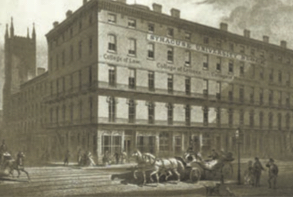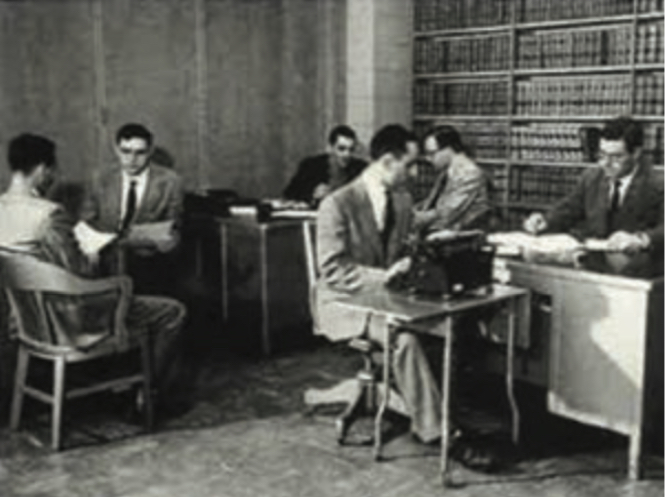Browsing the Growth of the Law Library from Bastable Block to Dineen Hall

Sources:
Jeffrey A. Unaitis, The Syracuse University College of Law: A Ninety Year Commitment to Excellence, 36 Syracuse L. Rev. 895 (1985). Margery C. Connor L’84, 100 Years: Syracuse University College of Law (1995).
“Pressing Wants”
When the College of Law opened in the Bastable Block in downtown Syracuse in 1895, students had access to the Court of Appeals Library. Containing approximately 20,000 volumes, this library was located nearby in the Onondaga County Courthouse, on the comer of Clinton and West Genesee streets.
The necessity of a dedicated and well-stocked law library to the educational and research mission of the College was evident from its founding, a fact expressed by University Chancellor James Roscoe Day in his 1896 report to the Board of Trustees:
“The College of Law immediately stepped out beyond experiment, and the report of the dean will show a remarkably loyal support of our renowned legal talent of the Onondaga Bar … It will find friends in due time to endow its library and meet other pressing wants. In the meantime, by the generosity of its friends, it has access to our noble law libraries and assistance to do its work in a satisfactory manner.”

A Growing Collection
The library was central to plans for growth when, in the fall of 1898, the College moved into the newly erected University Block on East Washington Street. Specially designed second- floor quarters included classrooms, office space, an assembly hall—and a library.
With space to expand its collections, in 1899, Louis Marshall, an eminent New York City lawyer and long-time friend and law partner of College of Law Dean James B. Brooks, dedicated a gift of 1,500 volumes to the memory of their mutual law partner, the Hon. William C. Ruger.
Later additions from the Marshall and Ruger collections, as well as from the Brooks Library, formed a new nucleus for the growing collection that now included full sets of the Reports of the US Supreme Court; court reports of the states of New
York, Massachusetts, New Jersey, Pennsylvania, Vermont, and Connecticut; and an entire set of English Reports, said to be a “verbatim reprint” covering 1307 to 1865.
“Make It Worthy”
In 1927, Harvard Law Scool Dean Roscoe Pound released his 25-page Survey of the College of Law of the University of Syracuse and Project for Its Reorganization. Known as “The Pound Report,” it found that the College had the “foundation” of a good library, but that a $25,000 investment would be needed to “make it worthy of the school.”
Illustrating the importance of research to the modern law school, Pound noted that law teachers were now expected to do more than “simply deliver a set number of lectures each week” and that part-time teachers couldn’t be expected to also perform legal research, work that “cannot be divorced from the teaching function.”
A “Working Tool”
Modernization of the Law Library continued in the late 1930s and early 1940s. Generous appropriations made by the University helped update the treatise section and supplement statutory services and the reports of court and administrative decisions. At this time a review of the library considered it an “adequate working tool” for its students, but needs continued to grow, especially after World War II.
In June 1953—thanks to a principal gift from Syracuse lawyer and businessman Ernest I. White—groundbreaking took place for a University campus building dedicated to the College of Law. Opened in September, this was the first time in its history that the College had occupied a facility built expressly for the study of law, with the 60,000-volume Law Library as its focal point. The dedication of White Hall included the following description of the library:
“… for effective legal education, the building centers about a law library in which the William Rubin Memorial Reading Room on the second floor opens directly into four decks of library stacks … the reading room has comfortable study space for 80 students and in the stacks are window-lighted carrels providing research space for an additional 44 students.”

Approaching Capacity
By 1974, with enrollment approaching 600 students, the original White Hall library had doubled its capacity to 120,000 volumes. Strategy for the next 10 years would be critical if the College was to maintain its growing position as a trailblazer in legal education.
In 1979 planning began in earnest—under the direction of Dean Craig Christensen and Law Library Director Thomas C. Kingsley—for a new library, along with a major renovation of White Hall.
Led by N. Earle Evans ’42, The Campaign to Build a Law Library started in 1981. By May 1983, 1,400 alumni and friends had contributed $2.3 million and ground was broken, with construction taking about 18 months. A generous gift from H. Douglas Barclay L’61, H’98 capped the campaign, and in March 1985 both the H. Douglas Barclay Law Library and the newly renovated White Hall were dedicated.
The Barclay Law Library was designed to hold 200,000 volumes, and it wasn›t long before yet another expansion was required. A 1990 survey found that the College now lacked adequate student workspace, seminar rooms, and courtrooms, so along with plans to build what became Winifred R. McNaughton Hall, the library was built out once again, taking over the fifth floor of White Hall.
Technologically Advanced
In May 2012, the College of Law broke ground on a
new headquarters across Irving Avenue from White and MacNaughton halls. The new building would provide a LEED- certified, high-tech living/learning environment to deliver a 21st century legal education. The 200,000 square foot Dineen Hall— named for the family that provided the lead gift in the fundraising campaign—was opened in September 2014.
The nearly 32,000-square-foot state-of-the-art library within Dineen Hall includes 44,000 linear feet of shelving; 560,000 volumes in print and microform, including sets of books received from law firm and private family collections; advanced study spaces; 42 computers; the spacious Bernard R. and Carol K. Kossar Library Reading Room; and the Peter Herzog L’55 and Brigitte Herzog L’75 Special Collections Room. All these assets are complemented by the library’s growing online presence, which maintains 41,532 electronic titles and 49 legal topics databases.

Eye Toward the Future
The Law Library always operates with an eye toward the future. Today, the library serves not only those students and faculty located in Syracuse but also students, faculty, alumni, and other legal practitioners throughout the world.
As with all libraries, the Law Library continues to digitize and provide access to analog and print resources that are critical components of a legal education and legal research. Digital stewardship, also referred to as digital preservation, will not only preserve the library’s unique materials but also will ensure continuous access to the collection, at any time, from anywhere, physically or remotely.
For example, recordings of moot court competitions, negotiations, and presentations are an excellent resource for the students in the Advocacy Program, and they must be preserved to keep them usable. Similarly, the library archives reflect not just the history of the College, but the history of the development of American law over the past 125 years.
Searchable text greatly increases capacity and ease of use for research, for students, faculty, and the legal community at large. Thus, the library will continue to leverage technology and expertise in order to make the records that document the law’s evolution available and accessible to all.
